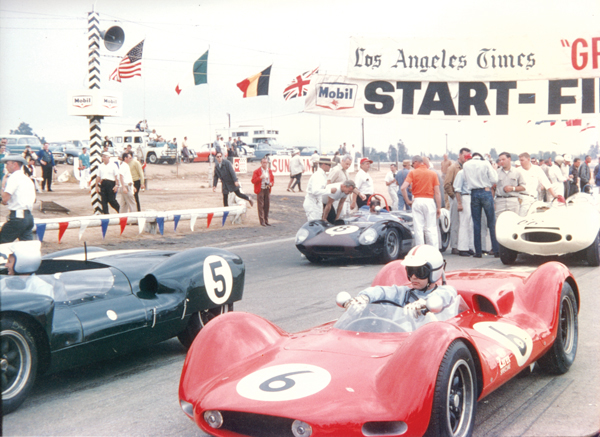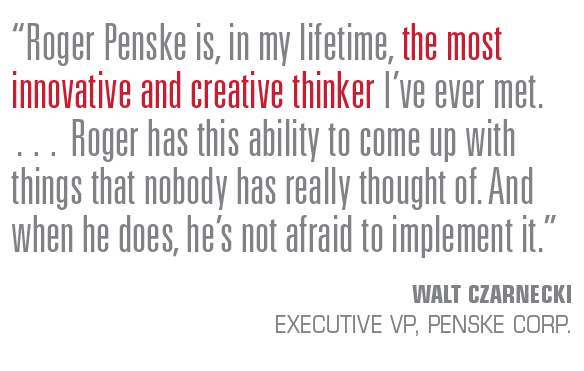Walt Czarnecki was working for Detroit-based American Motors Corp. in 1970, running both dealer marketing and the manufacturer’s racing program, when Roger Penske signed on to run AMC Javelins in the popular Trans-Am sports car series.
Late that year, Penske recruited Czarnecki to oversee a Chevy dealership he was building in suburban Detroit.
That next spring, with the dealership under construction and Penske’s race team wired to shatter the track speed record at Indy, Czarnecki headed to qualifying with three guests: an attorney working on their deal, a banker who would finance it, and an auto dealer who would be their next-door neighbor.
“I remember that day, we got there the morning of qualifications and those guys hung out with us on the pit wall,” Czarnecki said. “I introduced them to some people. And then we got on the airplane and went home. But it was spectacular. It wasn’t until fairly recently that I learned the term activation. But that was early activation. These guys can help us out. Let’s take them to Indy.
“From that earliest time we were using racing in business. And I know of no one else that did it at that level at that
 |
In 1962, Penske showed up at sports car races in the famed Zerex Special (No. 6).
Photo by: Team Penske |
time.”
To anyone in the garages of Indy in the early ’70s, Penske’s team was unlike any other.
While most teams’ garages looked like, well, auto garages, Penske’s was meticulously organized and scrubbed.
Engineers, mechanics and staff wore matching shirts, pants and jackets, all of them Sunoco yellow and blue. When Penske stumbled upon a California teen wearing yellow sneakers, he asked him where he got them and ordered a dozen for the team.
“It was attention to detail,” Penske said. “And we were trying to project a particular image for our sponsors. The branding had to be just right. We took the branding of the logos to the car, to the garage, to the transporter. We started to tie it all together. The crew shirts. In the old days it was just a shirt with a scroll-written name of the car — Sunoco Special. We spend hours now trying to lay out the cars to get the sponsors the right display from the standpoint of their logos.
“We started that.”
Penske often ran counter to the established culture in racing.
When Penske started slapping sponsor names and logos on his entries, the sports car sanctioning body told him they were against its rules.
“So I used to put tape on the side and it would blow off after a few laps,” Penske said. “And then the sponsor would be on the car.”
Penske’s history of working along the edges of the rule book is an indelible aspect of his racing persona.
It began in 1962, when Penske showed up at sports car races with a machine called the Zerex Special, a hybrid that put a sports car body on the chassis of a former Formula One single-seater. Because sports car rules require a passenger seat, Penske installed one slightly larger than a child’s car seat beside him, beneath the left-side panel, which he would raise during inspection to show that he had complied.
Though his opponents squawked, the SCCA ruled it compliant with the rules as written. The car won three races.
“People called it the unfair advantage,” Penske said. “We were just trying to be better than the next guy. We looked at the rules and said, what about this? That’s not in there. And that’s what people are doing today. … From that [approach] came the ingenuity in racing.”
Penske often has been out front of developments in aerodynamics and engines, sometimes to the chagrin of his competitors.
He was the first to be aggressive in putting wings on the front and back of his Indy cars, taking advantage of downforce to run faster than cars that generated more horsepower. He put gas tanks on towers 30 feet high in his pits, chilling the fuel so he could fit more in his cars’ tanks. He refused to pigeon-hole himself into any one race series, moving from sports cars to open wheel and then NASCAR, and eventually housing all of them under a single roof, allowing for shared overhead, information and personnel.
In the same way that he found gold between the lines of the rules with the Zerex Special, Penske put on a dominant performance at Indianapolis in 1994 with an engine that lived entirely within a loophole that married his ingenuity to the deep pockets of his business partners.
The push-rod engine that Penske took to Indy that year, financed by Mercedes and built in secrecy by an engine company in which he held a large stake, took advantage of a carve out that allowed push-rod engines more turbocharger boost than the overhead-cam motors that teams ran at the time. Because it was the only race that allowed the push-rod engine, no team had ever taken advantage of the opportunity, balking at the expense of building something for only one race.
With Mercedes’ backing, Penske elected to do so. His cars ran away with the race, taking two of three spots on the first row in qualifying and lapping the field after only 72 laps.
“Roger Penske is, in my lifetime, the most innovative and creative thinker I’ve ever met,” said Czarnecki, who was one of a handful of Penske executives and engineers who were aware that they were developing the engine. “A lot of his thoughts, after consideration and discussion, don’t see the light of day. But others do. Roger has this ability to come up with things that nobody has really thought of. And when he does, he’s not afraid to implement it.”
In NASCAR, where the sanctioning body has moved toward leveling the playing field by tightening the limits on modifications to the cars, Penske has run afoul of the rules several times in recent years. His team certainly is not alone in that respect. But for him, the stakes are greater than most.
“In this business, there are a lot of gray areas and fine lines with regard to rule books,” said Tim Cindric, who as president of Team Penske oversees all Penske’s racing operations. “We operate this thing with integrity. And it’s sometimes challenging. Because we’re not just representing a race team. It’s not just the reputation of a person. It’s the reputation of an entire empire that he’s built up. So when we’re questioned in terms of our integrity, it’s much more meaningful.”
What others are saying ...
“To accomplish what he has accomplished and to have done the things he has done and not to leave a lot of blood in the street — that’s something, really. I’m lucky to call him one of my best friends.”
— Rick Hendrick, owner of Hendrick Motorsports
“Over the years, our success continues to be how we hire and find people who fit our cultures. We can’t train someone to be nice. The parents do.”
— Greg Penske, Roger’s son and chairman and CEO of Penske Motor Group
“The professionalism he’s brought to motorsports really set the bar; I think you saw later on people try to emulate the professionalism and crisp presentation that Roger brought.”
— Rob Kauffman, co-owner of Chip Ganassi Racing and chairman of the Race Team Alliance
“I guess I see a whole bunch of different Roger Penskes. Because he’s very businesslike. All the t’s have to be crossed and the i’s have to be dotted. But he doesn’t run his personal life like that. And I’ve had a unique opportunity to see Roger both ways. He’s generous. He’s kind. He’s got a terrific sense of humor. He loves his children. He loves his wife. He’s just a good guy.”
— Edsel Ford II, Ford Motor Co.
“My dad used to have an expression. He’d say Roger could work both sides of the street just perfectly. And he can. He gives value to both groups he’s working with, or three groups if you need to. He’s able to do that.”
— Brian France, NASCAR chairman





